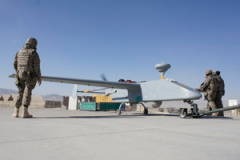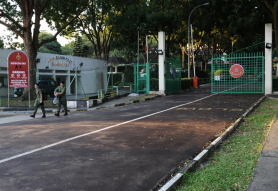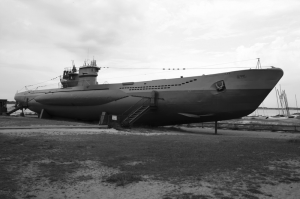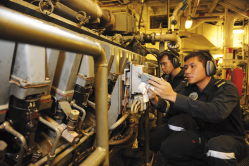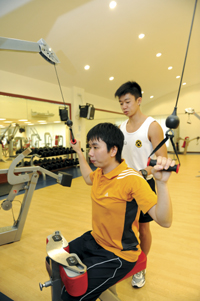There's something about the end of the year that puts one in a retrospective mood. Here at PIONEER, we check out 10 major events that happened this year and what 20 people say about them.
No two years in the Singapore Armed Forces (SAF) are alike. Faced with evolving security environments and unpredictable threats, the SAF is always on the move to stay abreast of changes.
This year, the SAF has been sharpening its operational capabilities to engage in a wider range of missions. It has also been proactive in training and developing its people professionally to better prepare them for more complex roles in the 3rd Generation SAF.
Assessing where the SAF stands in its 3rd Generation transformation journey at this year's SAF Day in July, Deputy Prime Minister and Minister for Defence Teo Chee Hean said: "Overall I would say that the transformation is going very well...I expect the developments on the 3rd Generation SAF will continue to unfold over the next five to seven years."
Missions accomplished
The best way to test the SAF's operational readiness is to put it through its paces. Besides defending the home ground, the SAF also participated in rigorous overseas missions, recognising that threats elsewhere in the world have the potential to disrupt Singapore's peace and stability.
Contributing its hardware and people to places such as Afghanistan and the Gulf of Aden allowed the SAF not just to realise its full set of capabilities, but also provide its personnel with a wealth of operational experience.
1. The fight against terrorism
To contribute towards multinational reconstruction efforts in Afghanistan and preventing it from being an unstable place from which terrorism is exported to the world, the SAF made multiple deployments to the war-torn country this year.
Weapon Locating Radar (WLR)and Unmanned Aerial Vehicle teams were deployed to the Uruzgan province to provide early warning against rocket attacks and surveillance to the international coalition troops operating there. A surgical team was also deployed there to provide medical support for troops and Afghan locals.
Elsewhere in Afghanistan, the SAF sent institutional trainers to train the Afghan National Army in an artillery school in Kabul, while a Construction Engineering Team supervised the construction of a clinic that would serve 10,000 families in the Bamiyan province. With the clinic completed, the SAF concluded its deployments to Bamiyan in October.
Said Lieutenant Colonel (LTC) Dinesh Vasu Dash, on commanding the WLR team in Afghanistan from January to June this year: "Seeing the kind of capabilities that the SAF has and is able to provide, we all gained a lot of confidence through this deployment about what we can contribute overseas."
"As NSmen, we are part of the operationally-ready force of the SAF and it's an honour to add our experience and skills to the SAF's contribution in Afghanistan's reconstruction and stabilisation efforts."
- Captain (CPT) (NS) (Dr) Tan Wah Tze, a consultant anaesthetist, on being deployed from April to May to Uruzgan as part of the surgical team
2. Combating piracy in the Gulf
Ships that ply the Gulf of Aden face increasing threats as pirate attacks continue to plague the vital maritime waterway. To combat piracy, the SAF deployed a task group comprising a Landing Ship Tank with two Super Puma helicopters from June to October, which operated under the ambit of Combined Task Force (CTF) 151.
Rear-Admiral (RADM) Bernard Miranda, a naval officer experienced in sea deployments, assumed command of CTF 151 from January to April this year. During his stint as the commander of the task force, the number of pirate attacks in the Gulf of Aden and Somali basin fell by 26 percent, compared with the same period last year.
On his stint as Commander CTF 151, RADM Miranda, Director Multinational Operations, noted: "We made excellent progress in all areas, and will continue to work hard at it. At the end of the day, we want to keep the area of operations safe for merchant shipping."
"It is very meaningful to take part in these operations to deter piracy and knowing that the SAF is always ready to respond."
- Military Expert 2 (ME2) Lui Jian Fong, Naval Warfare Systems Engineer, on being deployed as part of the task group from June to October
Cutting-edge tools and able people
To overcome the limitations of a small population, the SAF employs technology as a force multiplier, where the acquisition or development of advanced hardware offsets the need for more manpower.
However, the best tool achieves nothing without a capable hand to work it, which explains why the SAF develops its hardware capabilities in tandem with training its people. Together, they strengthen Singapore's total defence, serving as a good deterrence against aggressors.
3. Fortified arsenal
This year, the SAF beefed up its arsenal through the acquisitions and delivery of the Sikorsky S-70B naval helicopters and its second Archer-class submarine, the RSS Swordsman.
While these platforms pack sophisticated systems and equipment, it is their ability to integrate with other assets that creates a more potent combination in war-fighting, as witnessed in the integration of the naval helicopters and the Formidable-class frigates during an exercise in March conducted in San Diego, the United States.
On the challenges of operating and integrating the naval helicopter with the frigate, Major (MAJ) Goh Ker Jia said: "It was only after lots of flight hours, practice and hard work that we managed to perfect the technique."
On land, the introduction of the Terrex Infantry Carrier Vehicle (ICV) into the SAF last year has changed the way Infantry troops operate by offering them mobility, better combat and networked capabilities, and enhanced protection. With the need to train soldiers to operate alongside the Terrex ICV, the SAF established its first Motorised Infantry Training Institute (MTI) in October.
"Equipped with the BMS (Battlefield Management System), the Terrex connects all the combat power of the SAF such that the soldiers are fully linked to other friendly forces... and gives them the information they need to make decisions and for commanders to direct the battle."
- LTC Oh Beng Soon, Senior Project Officer, 9th Division/Infantry, on the merits of the Terrex ICV
4. Improving fitness levels
A slew of changes were made to the training of soldiers with the aim of preparing them better for their role in the 3rd Generation SAF this year. Tweaks were made to the Standard Obstacle Course (SOC), and the Vocational Obstacle Course and Vocation-Related Exercises were created for training to be more relevant and customised to the different vocations in the SAF.
To help Operationally Ready National Servicemen (NSmen) train progressively and sustain their fitness, the Individual Physical Proficiency Test (IPPT) and the voluntary IPPT Preparatory Training (IPT) were tweaked.
IPT was enhanced from a five-week to a nine-month programme, with customised Personal Performance Targets(PPTs) over the same number of training sessions, while the one-year NS IPPT window has been adjusted to cater for three months of remedial training should the NSman fail his IPPT.
CPL (NS) Chan Chi Thio commented that the enhanced IPT is "a more effective way for the fitness specialists to concentrate on my weaker areas and provide targeted coaching so that I'm more able to pass the IPPT".
"The new obstacles are more realistic and definitely increase my level of confidence when we're carrying out operations."
- Corporal (CPL) Mohamed Syakeer bin Abdul Rahim, an Infantry soldier from 3rd
Battalion, Singapore Infantry Regiment, on the benefits of the redesigned SOC
Fostering cooperation
In recent years, the range of security challenges to the Asia-Pacific region has grown wider to include terrorism, global health risks and environmental disasters, which cannot be solved by any one country alone.
As such, there is a need for countries in the region to develop habits of cooperation and band together to tackle threats that transcend borders.
5. Bringing defence to a larger table
At the inaugural ASEAN Defence Ministers Meeting (ADMM) in Kuala Lumpur in 2006, the idea of ADMM-Plus for ASEAN and other countries to exchange views on regional defence and security issues was already mooted.
This year, eight countries - Australia, China, India, Japan, New Zealand, the Republic of Korea, Russia and the United States - were welcomed to the first ADMM-Plus meeting convened in Hanoi, Vietnam, in October.
Minister of National Defence of Vietnam, General (GEN) Phung Quang Thanh,
emphasised that the ADMM-Plus serves as a platform for defence cooperation: "It is a mechanism of defence (cooperation) at the highest ministerial level, guiding and directing substantive cooperation programmes for an effective solution to common security challenges and emerging non-traditional security challenges."
"It provides an inclusive yet focused configuration, bringing together, for the first time, the defence establishments of all the key players in the region. The ADMM-Plus has great potential to bridge both dialogue and practical cooperation."
- Deputy Prime Minister and Minister for Defence Teo Chee Hean, on what the ADMM-Plus can achieve
"The warm and friendly defence relations between the two navies reaffirm the commitment of both nations towards strengthening defence cooperation for peace and stability in the region."
- Commander of the RBN, Yang Mulia Colonel Haji Abdul Halim bin Haji Mohd Hanifah, on the RBN's ties with the RSN
6. Forging closer defence ties
The SAF's network of defence ties among the regional and international community continued to be steadily strengthened this year. In June, the Republic of Singapore Air Force (RSAF) participated in Exercise Garuda for the first time, with the French and Indian Air Forces. This was its longest deployment to an exercise, covering 11,500 km from Singapore to the Orange and Istres air bases in France.
Commenting on the exercise, the French Air Force Exercise Director COL Jean-Paul Clapier said: "The exercise is a good way of allowing the three air forces to work together to accomplish their missions, enhance their skills, and learn from each other."
2010 also marked several milestones for the SAF's training exercises. Exercise Wallaby, held from September to November, was the SAF's 20th year of training in Australia's Shoalwater Bay Training Area, reflecting the close and long-standing defence relations between Singapore and Australia. The RSAF and the Indonesian Air Force celebrate the 30th edition of Exercise Elang Indopura this month, while the Republic of Singapore Navy (RSN) and the Royal Brunei Navy (RBN) commemorated the 30th anniversary of Exercise Pelican in June.
Building commitment in people
Back when Dr Goh Keng Swee was Singapore's first defence minister in the 1970s, he exhorted soldiers to have "steel in (their) souls" in the face of adversity. While the SAF has now grown from a fledgling armed forces to one that is capable and sophisticated, the need for such fighting spirit in soldiers has not changed as committed people remain the foundation on which the SAF is built.
Over the last 12 months, the SAF launched many new initiatives to appreciate its personnel for their commitment to defence, and to help them better understand the purpose behind what they do.
7. A better BMT experience
To enhance the overall training experience of Full-time National Servicemen (NSFs) during their Basic Military Training (BMT), a fourth Basic Military Training Centre (BMTC) school with improved facilities was added in June, allowing for better supervision with more commanders to guide the recruits.
On the expansion of the BMTC schools, CPT Gan Yee Hui, Officer Commanding of Raven Company at BMTC School 3, said: "As commanders, we place great emphasis on the overall experience that the recruits undergo, so as far as possible, we try to give them a holistic BMT experience."
And unlike previous years when recruits had their 24 km route march on Pulau Tekong, the route march on 1 Oct took recruits to the heart of Singapore at the Marina Bay Floating Platform. The intent was for recruits to march past iconic landmarks in Singapore to remind them of what they are training to protect.
"Memories of happy times spent here with family and friends came to mind as I walked through East Coast Park. It was then that I realised this was what we had been training to protect: our families, loved ones and the country we grew up in."
- REC Karthik Rajanindran from Taurus Company, on his thoughts about the graduation march to the city
8. Developing experts
The new Military Domain Experts Scheme (MDES) officially launched on 1 Apr is an attempt to attract and retain talent, and allows SAF personnel to deepen their specialisations in their field up to the age of 60.
Under this scheme, Military Experts are given more opportunities to develop greater depth of knowledge and competency through courses and academic awards.
On converting to the MDES, ME2 Muthukumaran, Unmanned Aerial Vehicle technician, 6th Army Maintenance Base, admitted that he felt "a little sad, because (he) always wanted to be known as Warrant Kumar, but also excited about all the opportunities the new scheme brings".
"I get to do what I enjoy, contribute longer to the organisation, retire later with no pay cuts and drops in benefits, and I don't have to look for a second career. When I retire at 60, my children would have already started working, so it's really a plus for me."
- ME3 Sim Hock Guan, Principal Staff Assistant, Air Force Logistics Centre, Air Logistics Department, on the advantages of MDES
9. Thanking our servicemen
The introduction of the NSF of the Year award in July and the announcement of the NS Recognition Award (NSRA) in August were ways to appreciate servicemen for their commitment and contributions towards defence.
While the former recognises NSFs for their outstanding contributions during their NS stint, the NSRA celebrates three significant milestones during a serviceman's NS journey and is paid out in three tranches.
CPT (NS) Mohamed Najib Mashuni, Officer Commanding, 731st Battalion, Singapore Infantry Regiment, said he was pleased that the Government "is recognising the sacrifices that we make as citizens who take time off from our families and careers to undergo our In-Camp Training".
"Give your best. In retrospect, I can firmly say that you gain as much out of NS as you put in. If you go in with an open mind and heart, and try to learn as much as possible, you'll gain more than you initially expect."
- 3rd Sergeant (NS) Khairul, Automotive Technician Specialist, 3rd Army Maintenance Base, an NSF of the Year award winner, on his NS experience
10. Giving to the nation
The SAF is not just about defence; it is also about contributing to the nation wherever possible. Besides conducting exercises, the SAF also organises events for the public to gain awareness of what it does, and provides support in events of national scale.
In May, the RSN opened its doors during the Navy Open House, and Singaporeans grabbed the opportunity to learn about what it does to protect the seas and shores of this island.
Apart from its yearly organisation of the National Day Parades, the SAF also provided logistical and medical support for this year's inaugural Youth Olympic Games (YOG).
Brigadier-General Ishak bin Ismail, Commander 6th Division (6 DIV), on what he went through as Chairman of the YOG Opening and Closing Ceremonies, said: "One of the greater challenges was to meet the expectations of the world and the nation on a limited budget.
"There were also operational challenges such as how we (6 DIV) structured ourselves to tackle areas, both military and civilian, effectively."
"I'm very grateful for this opportunity as the chance to be part of an international event does not often come your way. This whole experience has been a very unique journey."
- Lieutenant Muhammad Ashiq, who served as Assistant Secretariat for the YOG Logistics and Finance Committee, on why he took part in YOG
